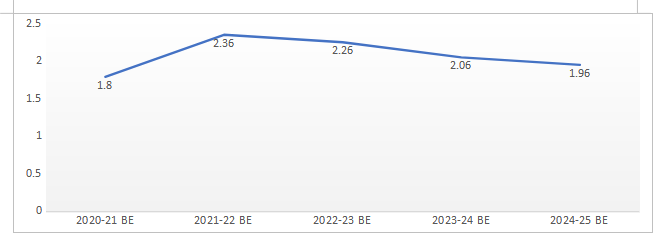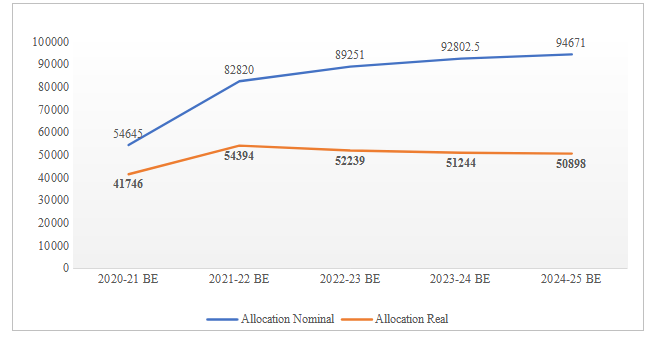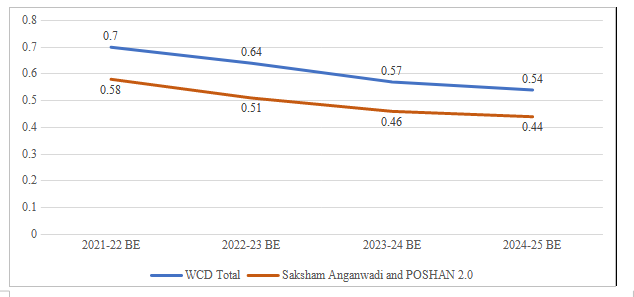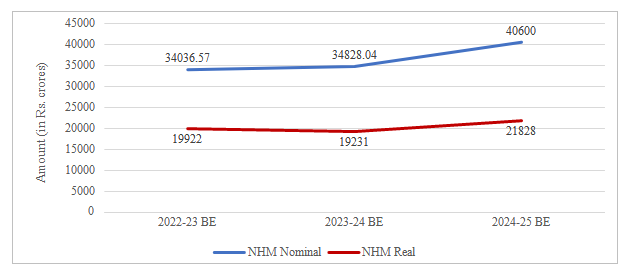The ruling Bharatiya Janata Party’s (BJP) Sankalp Patra for the 2024-25 Lok Sabha elections boasted of ``Guarantee for Swastha Bharat’’. However, the Union Health Budget 2024-25, coming soon after the elections, goes kaput on many of these!
The budget figures clearly show that priority for health in the Union government’s total budget has been declining – the total health budget as a proportion total government expenditure declined from 2.36% in 2021-22 BE (budget estimates) to 1.96% in 2024-25 BE (Figure 1). As a proportion of gross domestic product (GDP), the Centre’s expenditure on health continues the decade-long trajectory of hovering around 0.3%.

Although the nominal budgetary allocations show an increase, factoring in the element of price rise, there is a decline of 2.6% from 2022-23 BE and 0.6% from 2023-24 BE.

Digging further, the Union budget falls flat on a number of the avowed ``guarantees“. Let us look at some of these ``guarantees” vis-à-vis the budgetary commitments.
Guarantee to Expand PM-ABHIM
Against the BJP election manifesto’s guarantee of expansion in PM-ABHIM (Pradhan Mantri Ayushman Bharat Health Infrastructure Mission) for robust healthcare, the allocation for PM-ABHIM has consistently declined – from Rs. 5,846 crore (2022-23 BE) to Rs. 5,170 crore (2023-24 BE), to a drastic decline in the current year to Rs. 3,969 crore (2024-25 BE). The scheme includes the building of health and wellness centres, which have been a prop for the Narendra Modi government for advertising its work on health and which it is, in a spirit not warranted under the Indian Constitution, busy rebranding as ``mandirs“.
The PM-ABHIM was launched with much fanfare in 2021-22 to strengthen the public health infrastructure in effectively managing and responding to any future pandemics and outbreaks. It was touted as the largest pan-India scheme for public health infrastructure since 2005. However, just after a couple of years, the allocations have been cut, and in each year, till date, fund utilisation under the scheme has remained very low.
As recent as on July 1, celebrating the Doctors’ Day, the Prime Minister had assured that the ``government is fully committed to improving the health infrastructure in India“.
Guarantee to Augment Health Human Resources
After announcing this guarantee, just over a few months ago, the Union Budget 2024-25 has cut allocations for Human Resources for Health and Medical Education (under the National Health Mission or NHM) by Rs.5,225 crore, that is, a whopping 80% decline. This has decreased from Rs. 6,500 crore in 2023-24 BE to Rs. 1,275 crores in 2024-24 BE.
This programme was meant for fund transfers to states for establishing new medical colleges (upgrading district hospitals), upgradation/strengthening of nursing services, pharmacy schools/college, paramedical institutions and provisions increase of under-graduate and post-graduate seats in existing medical colleges.
Similarly, allocations have been reduced for the Health Sector Disaster Preparedness and Response and Human Resources Development for Emergency Medical Services scheme, implemented with the objective to build capacities in human resource to respond to health aspects of disasters, among other things. With the Covid-19 pandemic still fresh in minds, the allocation for this scheme has been slashed by 27% - from Rs. 128 crore to Rs. 94 crore.
During the pandemic, shortages in the health workforce and the stressful conditions they work in were all but clear. But there hardly appears to be any effort by the government to change the situation. Instead, what we are witnessing is the deplorable NEET (centralised medical entrance exam) scam.
Frontline workers, such as Accredited Social Health Activists or ASHAs and Anganwadi workers, who played an exemplary role during the pandemic, are still struggling to be recognised as full-time workers and their demand to get a regular wage is still unmet. This despite the global recognition of their work with the World Health Organisation awarding ASHA workers the Global Health Leaders Award in 2022.
Guarantee to Strengthen Disease Eradication Programmes
In Union budget 2024-25, the programme for the establishment and strengthening of NCDC (National Centre for Disease Control) branches and health initiatives for control of zoonotic diseases and other neglected tropical diseases has declined from a meagre Rs.55 crore to Rs. 52 crore.
As per the Global TB report, in 2022, India accounted for 27% of total TB (tuberculosis) cases in the world. India also accounted for 26% of global TB deaths (1.3 million), which comes to about 3.4 lakh people. These figures show that the claim to achieve a ``TB-mukt Bharat“ is nowhere near.
Guarantee to Ensure Women’s Health and Well-Being Despite claiming to work on women’s health as a priority, the allocations for the Ministry of Women and Child Development (WCD) have consistently declined over the past few years. And the trend continues in the third term of the Modi government, showing declining budget priority for this sector.
The allocation for the WCD Ministry as a proportion of total government expenditure has declined from 0.7% in 2021-22 BE to 0.5% in 2024-25 BE (Figure 3). This essentially means a decline in allocations for the Saksham Anganwadi and POSHAN 2.0 schemes which includes umbrella Integrated Child Development Scheme - Anganwadi Services, Poshan Abhiyan, Scheme for Adolescent Girls and form 80% of the WCD Ministry’s allocations.

All these are declining allocations in nominal terms. In real terms, the allocations have not just declined but are much lower than what appears on paper. In real terms, the allocation for the WCD Ministry has declined from Rs.16,048 crore in 2021-22 BE to Rs. 14,028 crore in 2024-25 BE – a decline of nearly 13%.
Dwindling Health Research
As a proportion of total health expenditure, health research remains a meagre 3.5%. With COVID-19 experience just behind us, it was expected that the government will invest on health research.
For the one component under the PM-ABHIM, which intends to work on Bio Security Preparedness and strengthening Pandemic Research and Multi Sector and National Institutions and Platform for One Health, the allocation has decreased by 35% - from Rs. 324 crores in 2023-24 BE to Rs. 212 crores in 2024-25 BE
Lacklustre National Health Mission
National Health Mission (NHM), which started as a flagship programme that was started in 2005 envisages the achievement of universal access to equitable, affordable & quality health care services that are accountable and responsive to people’s needs. NHM focuses on primary and secondary level of healthcare and comprises crucial areas such as maternal and child health, disease control programmes and non-communicable diseases. However, the present Government has been continuously starving this crucial scheme of funds.
Moreover, in the last couple of years, the Centre has been rejigging the various components of NHM, so much so that the tracking of budgets for NHM has become difficult as comparable figures are not available. The detailed composition-wise breakup that used to be available is no longer there. Further, the NHM does not figure in the list of ``Outlays on Major Schemes“ in 2024-25 and so to compare NHM allocations temporally is difficult.
For this analysis and to maintain consistency in schemes, we arrive at NHM figures by including the following components:
- Flexible Pool for RCH & Health System Strengthening, National Health Programme and National Urban Health Mission
- National Digital Health Mission
- AYUSH Mission
- Pradhan Mantri Ayushman Bharat Health Infrastructure Mission (PMABHIM) – NHM component

The allocation for NHM in real terms has increased only marginally this year (Figure 4). A real Swastha Bharat would require much more vigorous efforts at the primary and secondary level of healthcare. This would entail strengthening the public health system at primary and secondary level – such as more investments for health human resources, building of well-functioning and well-equipped health facilities including the HWCs, improved disease surveillance programmes, effectively tackling Non-communicable diseases, strengthening programmes such as NHM, and investing in health research, among other measures.
However, the priorities of the current dispensation appear to be misplaced. One, the priority for health sector is decreasing for this Government, and two, instead of strengthening the public health system, it continues to emphasise on private sector partnership and insurance-based models of healthcare delivery such as the Pradhan Mantri Jan Arogya Yojana (PMJAY). PMJAY continues to get fairly substantial amount of budget each year, even when the large body of evidence shows the inefficacy of such insurance-based models across the globe, evidence from the ground which continues to show that benefits from the scheme are limited, and with number of irregularities as pointed out by the CAG audit.
This article was originally published at https://www.newsclick.in/health-budget-2024-25-have-poll-guarantees-been-translated-action
